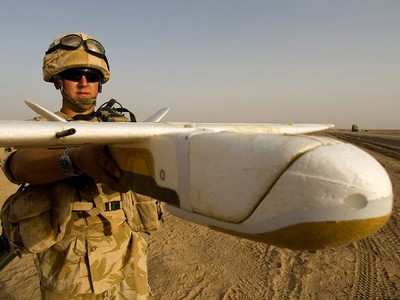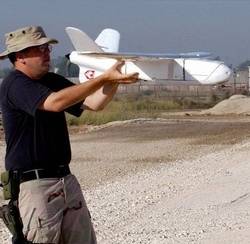Tue, Aug 24, 2010
Desert Hawks: Small UAV's Which Can Record Day And Night Video
For Transmission To Troops
Upgraded Desert Hawks - hand-launched, remote-controlled
surveillance aircraft which can record video footage day and night,
sending it directly to troops on the ground - arrived in
Afghanistan over the weekend. The latest version of the Desert Hawk
has been bought as part of a GBP3m Urgent Operational Requirement
to provide a further boost to the surveillance capability on the
front line.

File Photo
The Desert Hawk's cameras have been upgraded, giving a huge
improvement to image clarity and stability. It also has a new wing
design which improves its performance in the hot and high
conditions of Afghanistan. The aircraft is just three feet long,
with a wingspan of nearly 8 feet. It can fly for 90 minutes
with a range of nine miles. Desert Hawk is operated in Afghanistan
by the UK's 47 Regiment Royal Artillery. It is light and easily
transportable by patrols, weighing about 8 pounds. It can be
dispatched in ten minutes and is virtually undetectable once it is
in the air.
"Continuing to support this capability demonstrates our
commitment to ensuring that troops on the front line get the
cutting-edge equipment to help them in the fight against the
insurgents," said Peter Luff, Minister for Defence Equipment,
Support and Technology. "The improved Desert Hawk is a remarkable
piece of kit. It provides a detailed picture of what is happening
on the ground for our troops, giving them an operational advantage
and keeping them safer."

File Photo
"Desert Hawk provides an eye in the sky that has become
indispensable to troops on the ground in Afghanistan", said Staff
Sergeant Dan Gardner from 47 Regiment Royal Artillery, who recently
used Desert Hawk on operations in Afghanistan. "The fact that it is
hand-launched and lightweight means we get a very quick and
thorough appraisal of the tactical situations faced on operations.
It is used in a variety of roles, including reconnaissance and
surveillance of troops and patrols, and it provides valuable
situational awareness to commanders of troops in contact with the
enemy."
Desert Hawk is one part of the range of ISTAR assets that are
operated by the Royal Navy, Royal Air Force and Army to support our
forces in Afghanistan. The ISTAR aircraft systems supporting troops
in Afghanistan include:
- Sentinel aircraft and radar system which provides wide area
detailed surveillance of ground movements.
- Reconnaissance Airborne Pod for Tornado GR4, RAPTOR, which can
read the time on Big Ben in London from the Isle of Wight.
- Reaper, Desert Hawk and Hermes 450 remotely-piloted aircraft
which provide tactical levels of surveillance direct to troops on
the ground.
The RAF's combat ISTAR assets like Reaper remotely-piloted
aircraft and Tornado GR4 can provide detailed surveillance for
ground forces but can also deliver an armed response should it be
required.
More News
Aero Linx: Model Aeronautical Association of Australia MAAA clubs are about fun flying, camaraderie and community. For over 75 years, the MAAA has been Australia’s largest fl>[...]
Touchdown Zone Lighting Two rows of transverse light bars located symmetrically about the runway centerline normally at 100 foot intervals. The basic system extends 3,000 feet alon>[...]
“Discovery and innovation are central to our mission at Virgin Galactic. We’re excited to build on our successful record of facilitating scientific experiments in subor>[...]
How To Get A Story On Aero-TV News/Feature Programming How do I submit a story idea or lead to Aero-TV? If you would like to submit a story idea or lead, please contact Jim Campbel>[...]
Student Pilot Reported That During Rotation, “All Of A Sudden The Back Of The Plane Kicked To The Right..." Analysis: The student pilot reported that during rotation, “>[...]
 ANN's Daily Aero-Linx (05.02.24)
ANN's Daily Aero-Linx (05.02.24) ANN's Daily Aero-Term (05.02.24): Touchdown Zone Lighting
ANN's Daily Aero-Term (05.02.24): Touchdown Zone Lighting Aero-News: Quote of the Day (05.02.24)
Aero-News: Quote of the Day (05.02.24) ANN FAQ: Contributing To Aero-TV
ANN FAQ: Contributing To Aero-TV NTSB Final Report: Cirrus Design Corp SR20
NTSB Final Report: Cirrus Design Corp SR20




